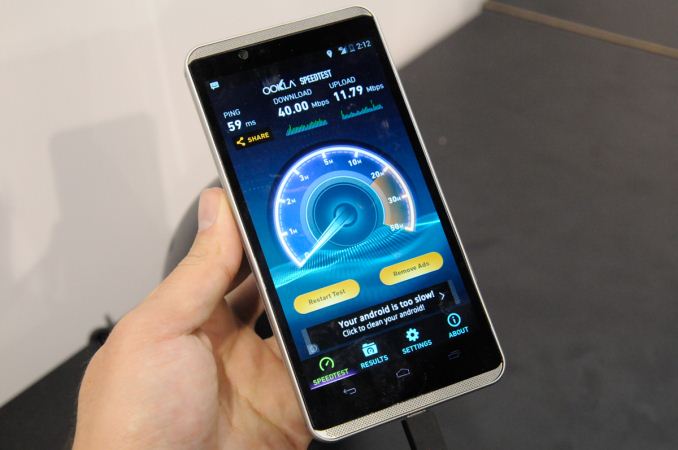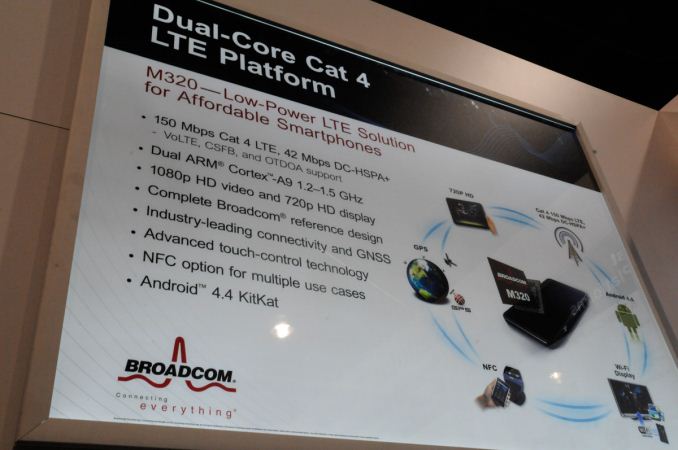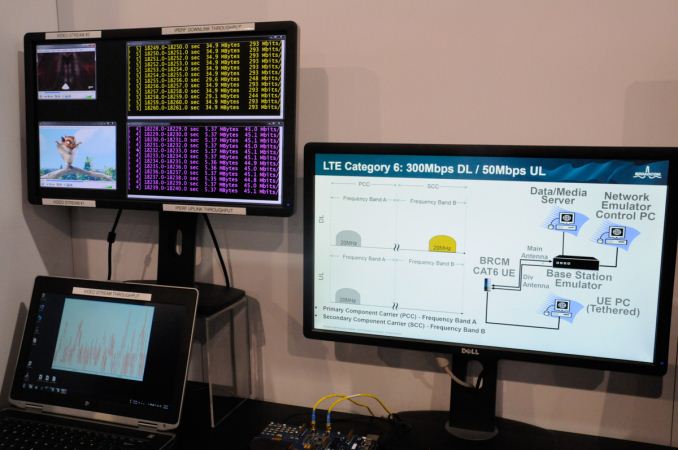Broadcom Teases Upcoming Cat 6 LTE Multimode Modem, M320 SoC with LTE
by Brian Klug on January 11, 2014 6:38 PM EST- Posted in
- Trade Shows
- LTE
- CES
- Broadcom
- CES 2014

Last year at CES we took a look at Broadcom's LTE modem portfolio, where the company showed off a Cat 4 LTE baseband doing 10+10 MHz carrier aggregation, before being formally announced at MWC. Since then a number of things have changed, including Broadcom's acquisition of LTE and SoC related Renesas Electronics assets, and subsequent restructuring of Broadcom's LTE modem plans. Its own LTE modem which we saw last year has been shelved in favor of a plan forwards with an M320 SoC with multimode capabilities and an upcoming standalone LTE modem.
At CES 2014, Broadcom showed off its M320 SoC which was based on the Renesas SoC platform. M320 combines two ARM Cortex A9 CPUs clocked between 1.2 and 1.5 GHz, PowerVR 5XT GPU, and Cat 4 LTE modem with DC-HSPA+ and GSM multimode capabilities. Broadcom prepared a reference design turnkey phone based on the M320 platform and showed it attached to AT&T and T-Mobile LTE on the show floor, and allowed me to run a few speedtests. The platform is already slated to be productized by Samsung in an upcoming smartphone which was under development even before the acquisition completed.
In addition, Broadcom teased an upcoming Cat 6 (300 Mbps) LTE modem cabled up to an Anritsu base station emulator showing 20+20 MHz carrier aggregation and delivering the expected 300 Mbps speeds on the downlink. Just like last year, it's easy to speculate that Broadcom might formally announce the name and details of this upcoming multimode LTE modem around MWC, although Broadcom isn't saying anything specific.


















18 Comments
View All Comments
extide - Sunday, January 12, 2014 - link
That is really up to the transceiver and amps, not the modem. The modem should work at any frequency that LTE works at.Rocket321 - Monday, January 13, 2014 - link
The way I understand it, the real question is how many ports (bands) can the modem expose to be built in. Right now most phones have at minimum an international and a US version because the modem doesn't have enough ports to simply build bands for every single WCDM + LTE channel in use. As newer modems add more ports, a truly "universal" handset becomes possible.lmcd - Sunday, January 12, 2014 - link
Look how the mighty Broadcom has fallen. Dual A9 in 2014? PowerVR instead of a successor to VideoCore IV?Excors - Sunday, January 12, 2014 - link
It's essentially a Renesas SoC, so it doesn't indicate much about what Broadcom would choose to design. Broadcom really wanted an LTE modem, and the deal with Renesas included this chip (and a quad-A7 successor, per their Analyst Day presentation) which can provide an immediate foothold in the LTE market. It'll take more time to integrate the new modem with the rest of their existing SoC IP.fteoath64 - Monday, January 13, 2014 - link
This is the new LOW-end from them. The competition from MediaTek is beginning to eat into their market and using comms as their advantage, QC hopes to claw back some customers.Chaser - Sunday, January 12, 2014 - link
Verizon/AT&T let me choose regular, reliable, 4G, 2GB data, unlimited talk and text for $45.00 a month instead of inventing these nearly useless "features" on a 3-5 inch display that you use to further fleece the country and make your executives richer.iwod - Sunday, January 12, 2014 - link
We need some competition, Qualcomm is currently setting the price for its expensive Modem. I am hoping Mediatek will soon give them a run for its money with their relatively cheap Modem solution. Broadcomm was suppose to do that but couldn't keep up the pace with Qualcomm.Heck even Intel couldn't keep it up since their Infineon acquisition.
Belegost - Monday, January 13, 2014 - link
I seem to need to make this same comment everytime another high speed WWAN article comes out. I feel like I should just save a copy and paste it in.The key piece of understanding for why very high data rate modems are important is this: the channel is SHARED. This is not about a single user getting a private 300Mbps connection, this is about the capacity of the whole cell shared among all the users.
A single cell has a fixed amount of resources, and it must divide up those resources amongst all the users of the cell. So, right now the popular modems in use are CAT3, which puts an upper limit of 100Mbps on each user - so if one user receives ALL the resources the cell has it will get up to 100Mbps.
But now there are ten users on the system that want data at the same time. LTE is nice for predicting behavior (unlike CDMA based tech like HSDPA and EVDO, which is a little more subtle) 10 users divide up the total resources in 10 pieces. So now if the cell is being fair to everyone, and they all have good connections, they receive 10Mbps at best. And to be clear, this is if everyone has ideal connection to the tower, more likely they will see 50-70% of that 10Mbps due to noise and spatial channel correlation. So 5-7Mbps - that's ok, but not great really.
Of course smartphone subscription rates are climbing fast, and more and more people are wanting data. So let's look towards a time when there are twice as many users - now 20 people want data, and each gets 5Mbps at best.Oh and channel conditions are rarely perfect, so let's bring that down to 3Mbps. Starting to get pretty slow...
So, newer modems on both sides can help the situation - one they do carrier aggregation, this expands the available resources by adding more spectrum to the cell. They can also move to higher density modulation (256QAM) and higher order MIMO to improve how much data can be sent over the same spectrum.
So let's say we move all the users in our 20 user scenario to CAT6 30Mbps equipment. Now each user could get up to 15Mbps, and a more realistic 9Mbps - those are good speeds that people will be happy with.
So please understand that the really high speeds being talked about are not suggesting that an individual user is going to see 300Mbps coming into their smartphone, but instead that the network will be better able to ensure 10Mbps+ connections to a larger number of users, and everyone will have a better experience using the system.